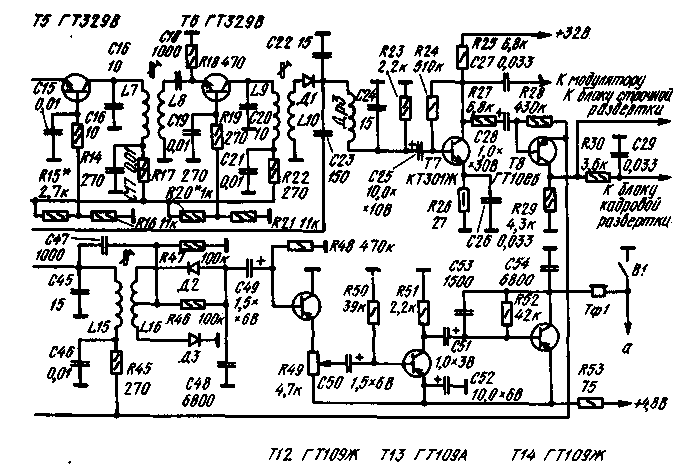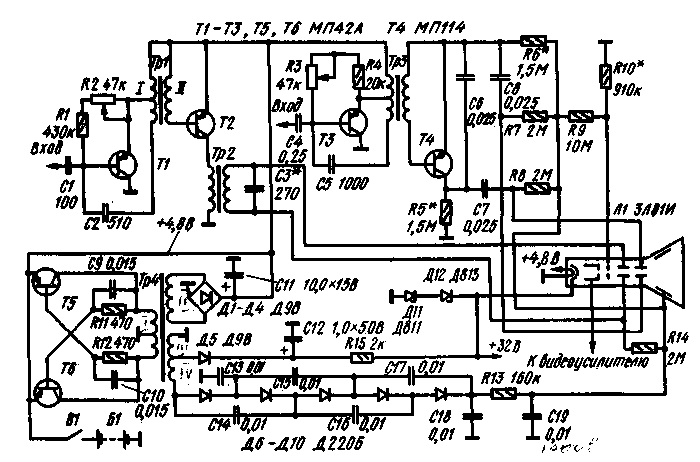
|
|
ENCYCLOPEDIA OF RADIO ELECTRONICS AND ELECTRICAL ENGINEERING MicroTV Vasilek. Encyclopedia of radio electronics and electrical engineering
Encyclopedia of radio electronics and electrical engineering / Телевидение The domestic industry produces several models of portable TVs, but they all have relatively large dimensions. Gorky radio amateurs A. Bondarenko and N. Bondarenko managed to design a TV, the dimensions of which are slightly larger than the size of a pack of cigarettes. TV "Vasilek" (as its creators called it) is designed to receive television broadcasts on one of the first three channels of the meter wave range. It is made according to the superheterodyne scheme. The sensitivity of the TV set with a voltage amplitude at the output of the video amplifier of 20 V is not worse than 8 μV. Image size diagonally 30 mm (Kinescope is a cathode ray tube ZL01I). Image clarity 150 lines. The Vasilek is powered by three STs-1,5 batteries. The consumed current does not exceed 700 mA. One set of charged batteries is enough for 1,2 hours of continuous operation. TV dimensions 112x71x33 mm, weight 420 g. The schematic diagram of the TV (with the exception of vertical and line scanners, voltage converter and voltage dividers) is shown in fig. one.
The signal from the antenna through the capacitor C1 enters the base of the transistor T1, which is a high-frequency amplifier. The transistor is on but in a common base circuit. The local oscillator is assembled on a transistor T3, in the collector circuit of which an oscillatory circuit L12C31 is included. From the coupling coil L11, the local oscillator signal is fed to the mixer (transistor T2). The amplified television signal (from the L2 coil) also comes here. The converted signal is amplified by transistors T4-T6, which are part of the image intermediate frequency amplifier (UPCHI). Transistors T4-T6 are included but in a common base circuit. The connection between the cascades is transformer. From the UPCH output, the signal goes to a video detector made on a D1 diode, and from it to a video amplifier (transistor T7) and to an intermediate frequency audio amplifier (UPCHZ) on T9-T11 transistors connected according to a common base circuit. The amplified video signal is fed to the cathode ray tube modulator. At the output of the UPCHZ, a frequency detector is switched on on diodes D2 and D3. A low-frequency amplifier is assembled on transistors T12-T14. Its load is a miniature telephone Tf1. On the transistor T8, an amplitude sync pulse selector is made. Separation of vertical and horizontal sync pulses is carried out by an integrating chain R30C29. The selected vertical and horizontal sync pulses enter the vertical and horizontal scanning unit, respectively. TV "Vasilek" is a modernization of a miniature TV set, developed by the participant of the XXIII All-Union Radio Exhibition, engineer Yu. Reutov. A number of nodes (blocks of horizontal and vertical scanning, power supply) "Cornflower" are the same as in Yu. Reutov's TV. A schematic diagram of these nodes is shown in Fig.2.
The horizontal and vertical sweep master generators, made respectively on transistors T1 and T3, are conventional blocking generators. The line scan output stage is assembled on a T2 transistor. The work of the vertical scanning output stage is based on the charge and discharge of the capacitor C5. The capacitor is charged from a high voltage source through resistors R5 and R6. The capacitor is discharged through the transistor T4. which opens with the arrival of a pulse from the master frame generator. To obtain all the voltages necessary to power the TV, a push-pull converter on transistors T5 and T6 and voltage doublers are used. Construction and details. For ease of repair, the TV is made from separate finished blocks. Details in blocks should be used small. Inductors Dr1 and Dr2 can be wound on ferrite rods used in the intermediate frequency circuits of portable transistor radios. Chokes should contain about 50 turns of PELSHO 0,16 wire. All coils are wound on textolite frames with a diameter of 5 mm. The tuning core with a diameter of 4 and a length of 4 mm is made of brass. Coil L1 contains 11 turns of wire PEV-2 0,41, L2 - 4 turns of the same wire, L3, L5, L7 and L9 - 20 turns of wire PEV-2 0,23, L4, L6, L8 - 6, and L10 - 12 turns of wire PEV-2 0,23, L11-2 turns of wire PEV-2 0,35, L12-8 turns of the same wire, L13-L15 - 60 turns of wire PEV-2 0,23, L16, L17 - 15 turns the same wire. The inductance of the inductor Dr3 should be about 70 μH. Transformers Tr1-Tr3 are made on the magnetic circuit Ш3Х6 from permalloy 50N. Winding I of the transformer Tr1 contains 350 + 350 turns of wire PEL 0,12, winding II - 110 turns of the same wire. For winding transformers Tr2 and Tr3, wire PEV 0,06 was used. Winding I of transformer Tr2 has 350 turns, winding II - 2500 turns, winding I of transformer Tr3 - 1200 + 1200 turns, winding II - 390 turns. The Tr4 transformer is made on a ring core made of M1000NN ferrite (core size K20X10X5). Winding I contains 15 + 15 turns of wire PELSHO 0,41, winding II - 20 turns of the same wire, winding III - 100 turns, and winding IV - 200 turns of wire PELSHO 0,12. Setting up the TV is carried out according to the generally accepted method and is not given in the article. Literature 1. The best designs of the 27th exhibition of amateur radio creativity. M.DOSAAF. 1977 Author: A. Gusev; Publication: N. Bolshakov, rf.atnn.ru
Traffic noise delays the growth of chicks
06.05.2024 Wireless speaker Samsung Music Frame HW-LS60D
06.05.2024 A New Way to Control and Manipulate Optical Signals
05.05.2024
▪ Remote ignition lock of a credit car ▪ Star Citizen is the most expensive game in the world ▪ Astronauts confirm: salt is dangerous
▪ section of the site Lecture notes, cheat sheets. Selection of articles ▪ article Winged words, phraseological units. Encyclopedia ▪ article Where Does the Wind Come From? Detailed answer ▪ article Maintenance of steam boilers for gaseous fuels. Standard instruction on labor protection
Home page | Library | Articles | Website map | Site Reviews www.diagram.com.ua |






 Arabic
Arabic Bengali
Bengali Chinese
Chinese English
English French
French German
German Hebrew
Hebrew Hindi
Hindi Italian
Italian Japanese
Japanese Korean
Korean Malay
Malay Polish
Polish Portuguese
Portuguese Spanish
Spanish Turkish
Turkish Ukrainian
Ukrainian Vietnamese
Vietnamese



 Leave your comment on this article:
Leave your comment on this article: